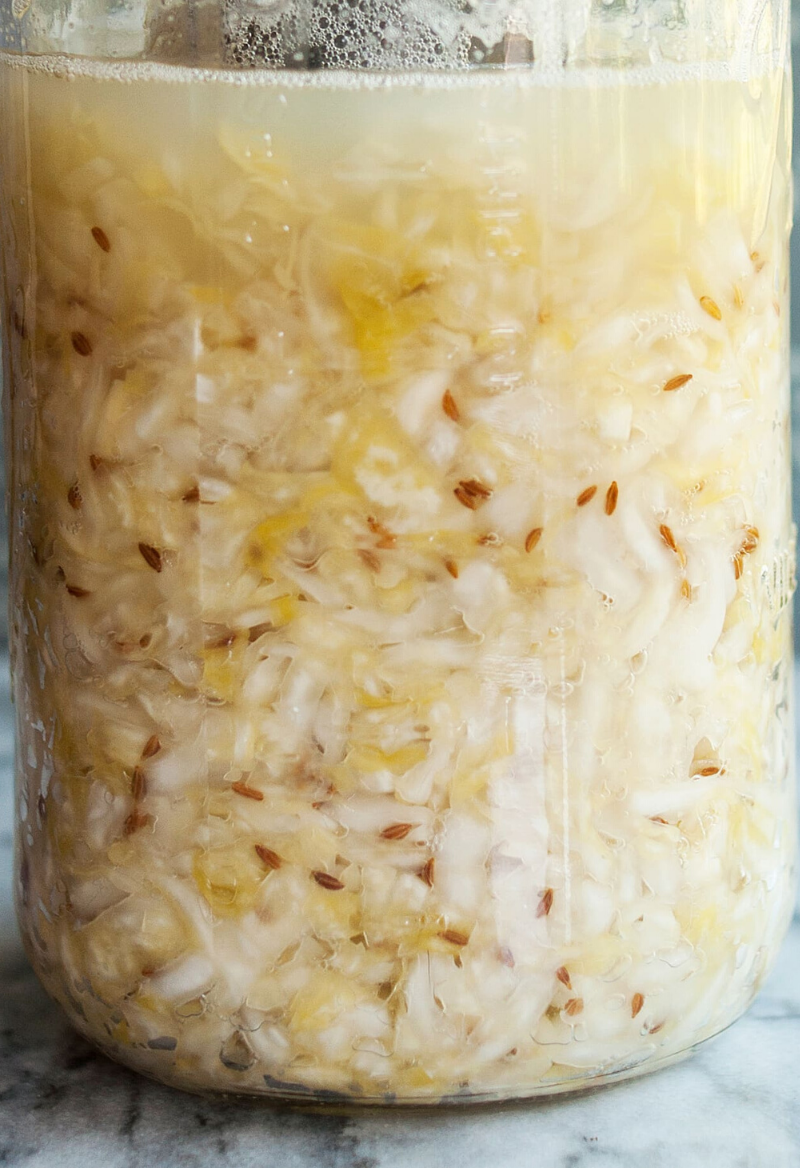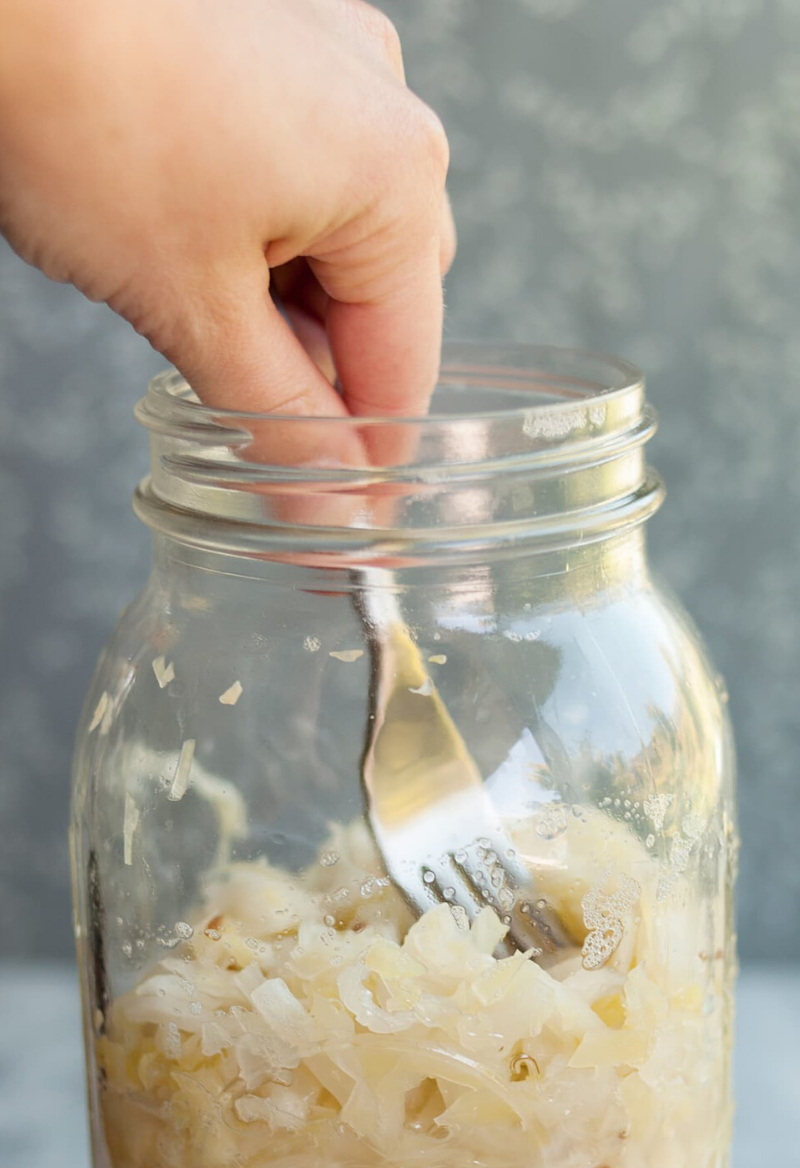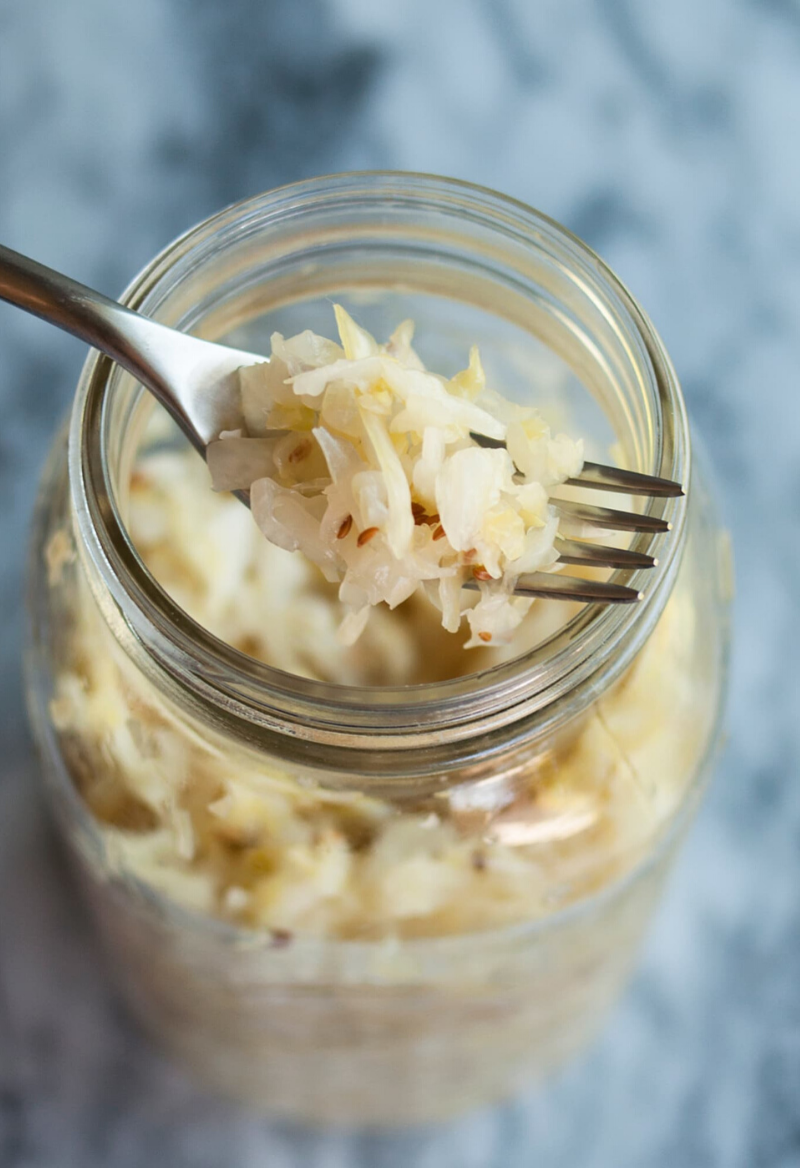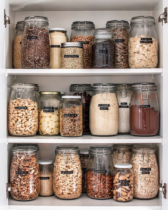
Sour, salty, and a little bit crunchy, homemade sauerkraut is surprisingly easy to make. You only need two ingredients: cabbage and salt, and then some patience to let the probiotics do their job. It’s an easy DIY project to get started with if you’re new to fermentation, and makes a complex and delicious condiment with incredible gut-healing benefits.
What is sauerkraut?
For those of you who are not familiar with sauerkraut, it’s a condiment made from thinly sliced raw cabbage that’s fermented using a process called lacto-fermentation. Raw cabbage is seasoned with salt, and allowed to ferment over a couple of days until it develops a sour, tart flavour.
While it’s commonly misconceived that sauerkraut comes from Germany (given the fact that it’s served with bratwurst), and the name “sauerkraut” has German origins — translating to “sour cabbage,” this fermented food actually has roots in China and Eastern Europe.
Is it good for you?
Like most fermented foods, sauerkraut is rich in beneficial bacteria that helps promote a healthy gut flora, and also supports your body’s immune system function. It’s a fibre rich food that aids digestion, balances blood sugar, and may help lower cholesterol.
Beyond digestive function, sauerkraut and other fermented foods are also great for metabolic and cardiovascular health. It is a good source of Vitamin A, K, and folate.
Why should you make it at home?
Store-bought sauerkraut is often pasteurised, which means it doesn’t have any of the beneficial bacteria. And since making sauerkraut at home is super inexpensive, doesn’t require any special equipment, and stays shelf-stable for months (store it in the fridge if it’s too hot outside), it’s a good idea to try your hand at making it at home.
Notes for making Sauerkraut:
It’s very easy to make sauerkraut, but here are a few tips that’ll ensure your kraut comes out perfectly every time:
- Slice the cabbage very thinly for the best texture. You can use a knife or a mandolin for this.
- You need to squeeze a LOT. Once you salt the cabbage, use clean hands to really massage and squeeze out all the liquid. This can take upto 10 minutes, and your hands might get tired, so take a break if you need to!
- Flavour it. Adding a little bit of flavour goes a long way in making delicious sauerkraut. Add some pounded garlic, grated ginger, toasted coriander, bay leaves, or a pinch of turmeric for a beautiful golden hue.
- Make sure to properly sterilise the jar in hot water before storing the sauerkraut to prevent contamination.
- Taste it. After letting it ferment for a couple of days, keep tasting your kraut (with a clean spoon or fork to prevent contamination) to check for sourness.
- Always use clean utensils and clean hands when dealing with fermentation projects. Make sure you don’t double dip while serving as these increases chances of contamination.
- As with any fermentation project, even if you do everything right, it could still get contaminated. So watch out for a putrid smell, mold, or any other signs that the kraut has gone bad. When in doubt, it’s best to start over.

How long does it take to ferment?
There is no correct answer to this — it really depends on a host of environmental factors. It usually takes about 3 days for fermentation to start, and you’ll need to keep tasting to check if it’s done. If you’ve seen signs of bubbling, a pleasantly sour smell, and it tastes tangy and sour, the fermentation is probably complete.
Consider that in colder climates fermentation takes longer, and warmer climates is faster. Even the quantity of cabbage will affect fermentation times — smaller quantities will be done faster than larger quantities
Ways to Eat Sauerkraut
There are so many ways to enjoy sauerkraut:
— Sandwich: add some kraut to your sandwich, or mix it in mayo/greek yogurt for a delicious sandwich spread
— Avocado toast: Smashed avocado, kraut, and a sprinkle of seeds served with or without a poached egg is delicious
— Grain bowls: Add a scoop of sauerkraut to any grain bowl
— Salad: Mix it up in your salad, or use the last brine remaining in your jar to make a salad dressing
— Eggs: Toss it with scrambled eggs and veggies, or serve it alongside a veggie frittata
— Burger: Sauerkraut is delicious as a burger topping or side (instead of dill pickles) for a bit of tang
— Condiment: Compliment any meal with the gut healing benefits of sauerkraut by simply adding a spoon on the side, akin to how you would add a chutney, salsa, or pickle.

How to Make Sauerkraut
YOU WILL NEED:
1 head of cabbage
Pink Himalayan salt / rock salt / table salt (2% by weight of sliced cabbage)
6-8 cloves of garlic, grated or minced
1 tbsp toasted coriander seeds
EQUIPMENT:
A kitchen scale, 1 glass bowl, 1 large glass jar to ferment, a muddler or a pestle, a muslin cloth/cheese cloth + rubber band to secure, a shallow dish or plate
DIRECTIONS:
- Sterilise your jar by pouring boiling water over it and drying completely. Make sure the jar is at room temperature before you add your ingredients.
- Prepare the cabbage by removing the base and the tough outer leaves. Divide the cabbage into four halves, and thinly slice each half using a knife or mandolin.
- Weigh the cabbage on the kitchen scale, and add 2% weight of salt — to get this number, multiply the weight of cabbage by 0.02. (You can go upto 3% salt by weight, but we prefer keeping it within the 2-2.5% range).
- Add the cabbage and salt to a large bowl, and using clean hands, start massaging the cabbage to release the liquid. Massage for at least 8-10 minutes to fully release all the liquid — we need a good amount of the liquid as this acts as the brine.
- Once the cabbage has reduced in volume, add your flavourings — grated garlic, toasted coriander, and mix.
- Transfer the cabbage into a clean sterilised glass jar, using your fingers to press down the cabbage until it is compact and the brine rises above it. You don’t want any air bubbles in the cabbage — use a muddler/pestle to really pack it down if required. The cabbage should be fully submerged in the brine to prevent any mold from growing.
- Fold the outer tougher leaves of the cabbage and press it down in the jar to keep the cabbage submerged. Make sure you leave about an inch of space in the jar so it has room to expand. Cover the jar with a muslin cloth, and secure with a rubber band around the neck.
- Place this jar in a shallow dish or plate and leave to ferment in a warm place — in case there’s any brine overflowing, this dish will catch it. Discard the overflow and let it ferment as usual.
- You should check the jar everyday for signs of fermentation — remove the cover every day and release the air inside; this is called “burping.” You should see bubbling within the first 3 days, which means there’s microbial activity and fermentation is underway.
- Fermentation can be done in as quick as 3 days, or take upto 2 weeks depending on the climate you are in. 5 days was a sweet spot for us. Taste after 3 days — a pleasant sour smell, crunchy texture, and tangy taste means your kraut is ready. Once your sauerkraut is fermented and ready, screw on the lid of the jar and store in a cool place or the fridge.
Recipe Notes:
- Make this with regular cabbage or red cabbage.
- Add flavourings as per taste — try a mix of herbs and spices.
- You don’t have to make kraut out of a whole head of cabbage. Make smaller batches if you prefer, and just adjust the ratio of salt accordingly.
All Photos: Emma Christensen / The Kitchn







Enjoy making and eating it.